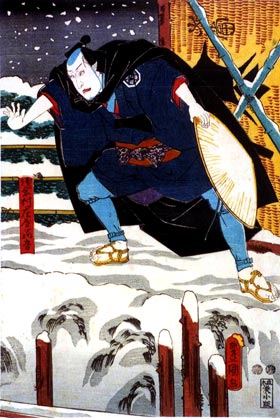| SAKURA GIMINDEN |
| Play titles | Higashiyama Sakura S˘shi Sakura S˘shi Gonichi no Bundan |
| Common titles | Sakura Gimiden Sakura S˘go |
| Authors | Segawa Jok˘ III ("Higashiyama Sakura S˘shi") Kawatake Shinshichi II ("Sakura S˘shi Gonichi no Bundan") |
| History |
"Higashiyama Sakura Z˘shi" was premiered in the 8th lunar month of 1851 August at the Nakamuraza [casting]. The true incident on which the play was based occurred in 1653 (the direct appeal). When it was dramatized, the names and details, even the era (Muromachi instead of Edo), were changed because of censorship by the shogunate government. For example, the head of the village Kiuchi S˘go, the evil lord Hotta Masanobu and the sh˘gun Tokugawa Ietsuna became Asakura T˘go, Orikoshi Masatomo and Ashikaga Yoshimasa in the drama. Segawa Jok˘ III mixed in his drama the farmers riot and elements taken from Ryűtei Tanehiko's popular novel "Nise murasaki Inaka Genji" (commonly called "Inaka Genji"). This drama was revised by the playwright Kawatake Shinshichi II. He got rid in his version of the "Inaka Genji" elements. It was staged in the 8th lunar month of 1861 at the Moritaza [casting] under the title "Sakura S˘shi Gonichi no Bundan". The drama was revised during the Meiji era and the real names of the main protagonists were used instead of the names created by Segawa Jok˘ III. |
| Structure |
The drama "Sakura Gimiden" is made up of 7 acts. The usually-performed acts are III (the family separation) and V (the direct appeal). |
| Key words |
Ashikaga Yoshimasa Haritsuke Hyakush˘ Ikki Sewamono Tokugawa Ietsuna |
| Summary |
Act III: the family separation "Sakura Gimiden" is an unusual Kabuki play about political protest. In fact it is the only play of its kind, and concerns the plight of farmers subjugated and squeezed dry through crippling taxes imposed on them by corrupt, money-hungry samurai officials. The hero of the story is Kiuchi S˘go, the mayor of the village of Sakura in what is now Chiba prefecture, and his character is based on a historical figure of the same name. The basic premise was rather simple. Farmers in 17th century Edo had banded together to protest the harsh treatment of the Hotta overlords. The behavior of the members of each social stratum was strictly controlled by the shogunate government and it was forbidden for commoners to appeal to higher authorities, irrespective of the merits of their case. However, the poverty in Sakura is so desperate that the mayor, S˘go, decides to appeal to the sh˘gun although his action will automatically mean the death penalty for not only himself but also his family members. S˘go visits his family for the last time and his children cling to him and try to stop him from leaving. S˘go is a loving father, torn between his desire to stay with them and his commitment to leave and see his duty through to its fatal end. In order to spare his family he gives his wife divorce papers, but she refuses to accept them and chooses to die with him. Act V: the direct appeal S˘go succeeds in sneaking into the Kan'eiji temple and runs to the procession led by the sh˘gun Tokugawa Ietsuna. Guards rush to capture him and his appeal letter is taken by the daimy˘ Matsudaira Izu-no-Kami, who pretends to throw it away but secretly hides it in his sleeve in order to give it to the sh˘gun later on. A brief summary of usually-ommitted acts (occasionally revived at the National Theatre) K˘zen is the old, emaciated abbot of Bukk˘ji Temple, and S˘go's uncle. He has been praying fervently for 37 days for leniency in the case, but when news comes that S˘go and his wife were forced to watch the decapitation of all four of their children before being crucified themselves, his rage transforms him into a demon. In the next scene, the ghosts of S˘go and his wife, and of K˘zen seem to haunt Lord Hotta and he lashes out killing his own sister and a visiting priest by mistake. The final scene depicts the 100th anniversary of S˘go's death at which both S˘go's and Hotta's descendants are reconciled, S˘go is honored and a temple is ordered to be built in his name. Texts for Act III and the usually-ommitted acts are courtesy of Jean Wilson (1998) |
| Trivia |
It is a well-established custom for actors about to perform the role of S˘go to visit the descendant of the Kiuchi familly and the temple where Kiuchi S˘gor˘ is enshrined, in the city of Narita (Chiba prefecture). During the run of the play a temporary shrine is erected within the theater before which daily offerings are made. |
 |
 |
|
The actors Band˘ Hikosabur˘ IV and Ichikawa Kodanji IV playing the roles of the boatman Jinbei* and Asakura T˘go in the drama "Higashiyama Sakura Z˘shi", which was staged in the 8th lunar month of 1851 at the Nakamuraza (print made by Utagawa Toyokuni III) (*) the boatman Jinbei ferries S˘go to his home in defiance of the local edict. He is a warm character, who at his age doesn't really care if he's caught and given capital punishment by the authorities; he'd rather help his old friend see his family for the last time. |
|
|
|
| Contact | Main | Top | Updates | Actors | Plays | Playwrights | Programs | Links | FAQ | Glossary | Chronology | Illustrations | Prints | Characters | Derivatives | Theaters | Coming soon | News |